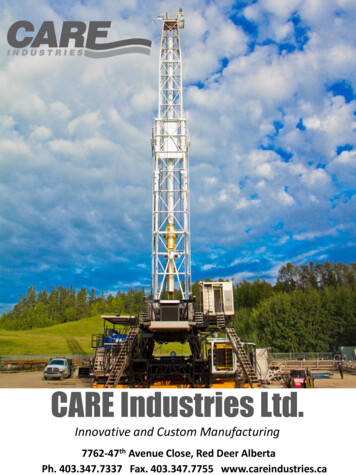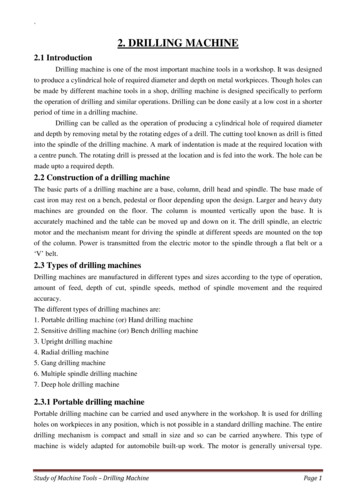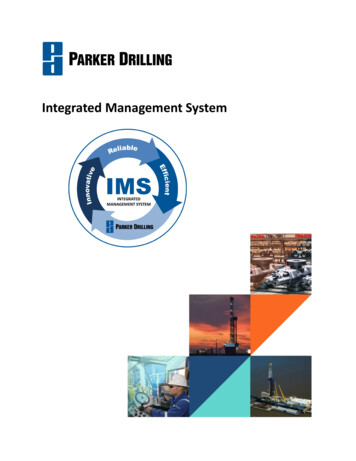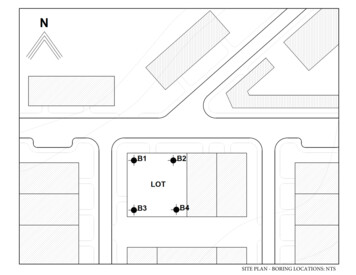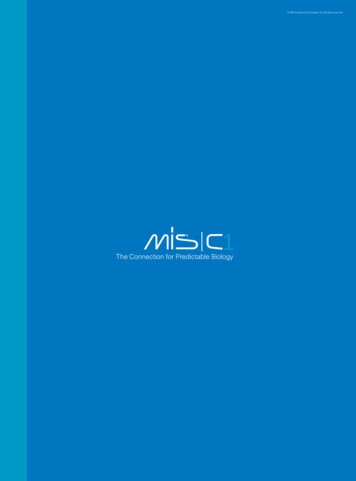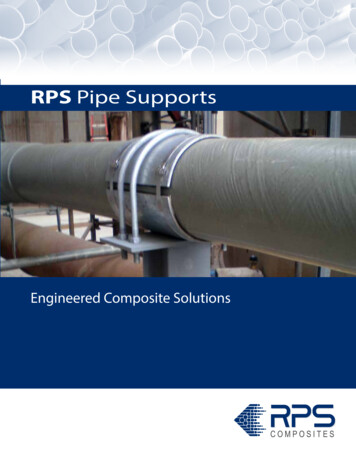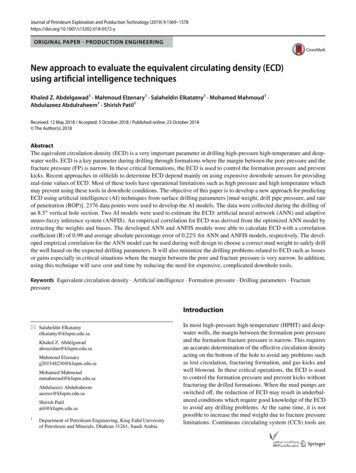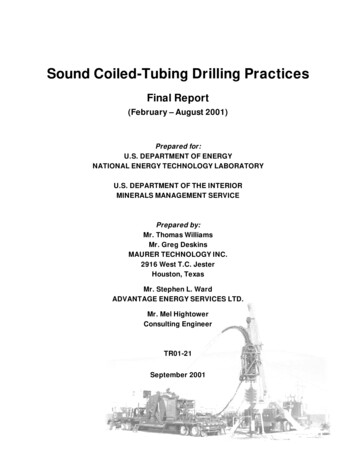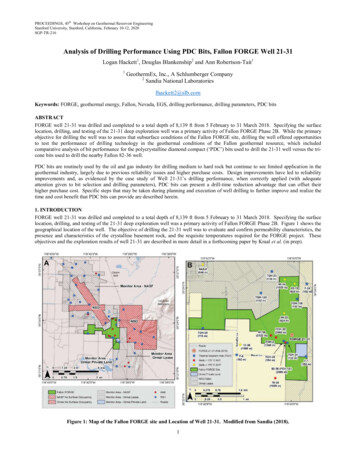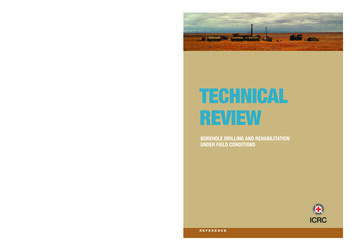
Transcription
TECHNICALREVIEW0998/002 02.2010 1,000BOREHOLE DRILLING AND REHABILITATIONUNDER FIELD CONDITIONSREFERENCE
MISSIONThe International Committee of the Red Cross (ICRC) is animpartial, neutral and independent organization whoseexclusively humanitarian mission is to protect the lives anddignity of victims of armed conflict and other situations ofviolence and to provide them with assistance.The ICRC also endeavours to prevent suffering by promoting andstrengthening humanitarian law and universal humanitarianprinciples.Established in 1863, the ICRC is at the origin of the GenevaConventions and the International Red Cross and Red CrescentMovement. It directs and coordinates the international activitiesconducted by the Movement in armed conflicts and othersituations of violence.International Committee of the Red Cross19, avenue de la Paix1202 Geneva, SwitzerlandT 41 22 734 60 01 F 41 22 733 20 57E-mail: shop@icrc.org www.icrc.org ICRC, February 2010 Cover photo: T. Nydegger/ICRC
TECHNICALREVIEWBOREHOLE DRILLING AND REHABILITATIONUNDER FIELD CONDITIONSICRC Borehole Technical Review.indd 119/02/2010 17:14
CreditsCover photo and Abstract: T. 11213141516171819203Drawing by D. SoulsbyD. Soulsby/ICRCD. Soulsby/ICRCConsallen Group Sales LtdPAT-DRILLT. Nydegger/ICRCDando Drilling RigsSameer Putros/ICRC (left), Los Alamos National Laboratory (right)Andrea Guidotti/ICRC (top), Sameer Putros/ICRC (bottom)Drawing by D. SoulsbyOFI Testing Equipment, Inc.Drawing by D. SoulsbyDrawing by D. SoulsbyDrawing by D. SoulsbyD. Soulsby/ICRCDrawing by D. SoulsbyD. Soulsby/ICRCGeoModel, Inc.GeoVISIONDrawing by D. SoulsbyDrawings by D. SoulsbyICRC Borehole Technical Review.indd 219/02/2010 17:14
ForewordForewordThis technical review presents and synthesizes an impressive amount of practical experience inthe field of borehole drilling and rehabilitation.David Soulsby- author of this publication and a seasoned geologist/geophysicist/water engineer- strikes the right balance between theoretical and practical knowledge while adopting theapproach of a scholar/practitioner. There is no doubt that his work will greatly help the ICRC'sWater and Habitat engineers address technical dilemmas under difficult field conditions.However, the ICRC's field experience reveals that in water-stressed regions afflicted by armedconflicts or rising tensions, there are no easy answers. This said, sustainability for the peoplebenefiting from water projects can be reached when a cost-effective solution is part and parcelof a comprehensive analysis putting the dignity and the needs of the community at the centrewhile addressing wider environmental concerns.This is the first Water and Habitat publication in the ICRC's new series, 'REFERENCE.' It is animportant contribution to the Water and Habitat unit's efforts to promote good field practiceswithin its staff and amongst other humanitarian players.I am extremely grateful to two successive Chief Hydrogeologists, Mr Jean Vergain who initiatedthis valuable work and Mr Thomas Nydegger who provided invaluable guidance throughoutthe editing of the Review. Finally, I wish to extend my thanks to Ms Anna Taylor who gaveconstructive advice as a reviewer and structured the final version of the manuscript.Robert MardiniHead of the Water and Habitat Unit3ICRC Borehole Technical Review.indd 319/02/2010 17:14
TECHNICAL REVIEWAbstractBoreholes are one of the best means of obtaining cleanwater in field conditions. However, constructing, or repairing,boreholes requires specialized knowledge and technicalexpertise, much of which can be gained from the standardliterature; but field operations in remote areas or in difficultconditions often require flexibility and imagination in avoidingand solving technical problems. This review is intended as adecision-making tool to assist in making cost-effective choicesbetween borehole drilling methods, and in deciding whetherto drill new boreholes or rehabilitate existing sites. The endresult should be a cost-effective facility capable of supplyingpotable water for many years.4ICRC Borehole Technical Review.indd 419/02/2010 17:14
Table of contentsTable of ContentsForeword3Abstract4Glossary91Introduction and executive summary132Groundwater and the advantages of 4.1.14.1.24.1.34.24.2.14.2.2Exploiting groundwaterGeological constraintsBorehole sitingTypes of geological formationGroundwater extractionAdvantages of drilled boreholesDisadvantages of drilled boreholesMethods of drilling boreholesCommon drilling methodsDrilling equipmentChoosing a drilling rigPercussion drillingHeavy duty cable toolRotary drillingDrilling rig componentsDrill bitHammer15161819212223252631313232333535365ICRC Borehole Technical Review.indd 519/02/2010 17:14
TECHNICAL .56.1.66.26.2.16.36.3.16.3.26.3.377.17.2Borehole constructionConstruction considerationsMud rotary drillingCompressed air rotary drillingBorehole loggingBorehole design, development, and completionBorehole construction designBorehole casingBorehole well screensGravel packPump selectionSealing the boreholeExamples of borehole designBorehole developmentDevelopment methodsBorehole completionSanitary sealPumps and test pumpingGeophysical loggingDrilling/Construction costsBuying a rigSuccess Borehole deterioration859Borehole monitoring8910Borehole .2.510.2.6When to rehabilitateRehabilitation methodsInspection by CCTVBreaking up of clogging deposits and incrustationsReliningBorehole sterilizationStep-drawdown testingMechanical repair93949596991011021026ICRC Borehole Technical Review.indd 619/02/2010 17:14
Table of Contents11Working with contractors103Selecting a contractorContract documentation10310411.111.2AnnexesAnnex 1Annex 2Annex 3Annex 4Annex 5Annex 6Annex 7105Example of a drilling log sheetRecent quoted prices for casings and screensExamples of borehole construction designsExample of test pumping data sheetBasic drilling contract: Clauses and specificationsList of items on contractor work/charge sheetsProduct references and further readingIndex106107109111113119122125List of tablesTable 1Table 2Table 3Table 4Table 5Table 6Table 7Table 8Table 9Typical porosities and permeabilities for variousmaterialsComparison of drilling methodsMud rotary: Circulation fluid flow rates for a rangeof drill bit and drill pipe sizesAir drilling: Maximum drill bit sizes for a rangeof compressor capacities and drill pipe sizesTypical casing collapse strengthsCasing diameters and screen openingsChoice of screens and gravel pack for variousground conditionsQuantity of chlorine compound to produce a50 mg/l solution in 20 m of water-filled casingBorehole monitoring: Symptoms, causes, and remedies172947485558617890List of figuresFigure 1Figure 2Figure 3Figure 4Figure 5A hypothetical hydrogeological scenarioA mud rotary machine working in easternZimbabwe, 1996Air rotary machine developing a successfulborehole, South Africa, 1989The Forager 55 cable-trailer rig in useA PAT 201 drilling rig; in the foreground is an auger drill19282932337ICRC Borehole Technical Review.indd 719/02/2010 17:14
TECHNICAL REVIEWFigure 6Figure 7Figure 8Figure 9Figure 10ICRC PAT 401 in action, northern Uganda, 2008The Dando Watertec 24 drilling rigThree common types of drill bitA DTH hammer button bitSchematic section of an example of temporary boreholecompletionFigure 11 The Marsh funnel viscometerFigure 12 Schematic plan view showing mud pits andmud circulationFigure 13 Water flow through a V-wire screenFigure 14 Sealing the bottom end of mild steel casing bythe welded ‘saw-teeth’ methodFigure 15 Measuring the blowing yield of a newly drilled boreholeFigure 16 Typical test-pumping set-upFigure 17 A test-pumping rig in operation (it consists ofa belt-driven mechanical rotary (Mono) pump), ZimbabweFigure 18 Casing damage as seen through a borehole CCTV cameraFigure 19 A CCTV borehole cameraFigure 20 Air-lifting in borehole rehabilitation34353536384345576369747595961008ICRC Borehole Technical Review.indd 819/02/2010 17:14
GlossaryGlossaryAquiferA subsurface rock or sediment unit that is porousand permeable and contains water. In an aquiferthese characteristics are highly developed: usefulquantities of water are stored and transmitted.ConfinedAn aquifer that is bounded above and below byimpermeable rock or layers of sediments. There mayor may not be enough pressure in the aquifer tomake it an ‘artesian aquifer (piezometric level aboveground level).’1PerchedUsually, an unconfined aquifer that is resting on animpermeable layer of limited extent surroundedby permeable formations or surmounting anotherunconfined aquifer.UnconfinedAn aquifer that is not overlain by an impermeablerock unit. The water in this aquifer is underatmospheric pressure. This kind of aquifer isreplenished by rainfall in the area of its watershed orby infiltration from a river.1BedrockSolid rock present beneath any soil, sediment orother surface cover. In some locations it may beexposed on the surface of the Earth.1FormationA laterally continuous rock unit with a distinctive setof characteristics that make it possible to recognizeand map from one outcrop or well to another. Thebasic rock unit of stratigraphy.1HostThe rock formation containing the water. The rockand the water together form an aquifer.FractureAny local separation or discontinuity plane in ageologic formation, such as a joint or a fault thatdivides the rock into two or more pieces. Fracturesare commonly caused by mechanical stressexceeding the rock strength. 29ICRC Borehole Technical Review.indd 919/02/2010 17:14
TECHNICAL REVIEWGroundwaterWater that exists below the water table in the zoneof saturation. Groundwater moves slowly, andfollows the water table’s slope.1IgneousImperviousFormed by the crystallization of magma or lava.JointsA fracture in rock along which there has been nodisplacement. 1LithologyThe study and description of rocks, includingtheir mineral composition and texture. Also usedin reference to the compositional and texturalcharacteristics of a rock.1MetamorphicA term used to describe a rock whose mineralcontent, textures and composition have been alteredby exposure to heat, pressure and chemical actions,usually in the course of tectonic burial and/ormagmatic activity.1MudstoneA sedimentary rock composed of clay-sizedparticles but lacking the stratified structure that ischaracteristic of a shale.1PermeabilityA measure of how well a material can transmitwater. Materials such as gravel, that transmit waterquickly, have high values of permeability. Materialssuch as shale, that transmit water poorly, have lowvalues. Permeability is primarily determined by thesize of the pore spaces and the degree to whichthey are interconnected. Permeability measures areexpressed in units of velocity, such as centimetresper second.1PoresVoids in a rock including openings between grains,fracture openings and caverns.1PorosityThe volume of pore space in rock, sediment or soil.Usually expressed as a percentage.1SandstonesSedimentary rock composed of sand-sized particles(1/16 to 2 millimetres in diameter) consolidatedwith some cement (calcite, clay, quartz). 1ShalesThinly laminated sedimentary rock made of tinyclay-sized sedimentary particles.Impermeable. An impervious layer is a layer ofrock, sediment or soil that does not allow waterto pass through. This could be caused by a lack ofpore space, pore spaces that are not interconnectedor that are so small that water molecules havedifficulty passing through.110ICRC Borehole Technical Review.indd 1019/02/2010 17:14
GlossaryUnconsolidatedPoorly cemented or not at all (in reference tosediments).WadiA stream that fills up after rainfall, but which isusually dry the rest of the time.WeatheredEarth rocks, soils and their mineral content whichunderwent decomposition by direct contact withthe planet's atmosphere, water, light, frost andheat.112Adapted from “Geology dictionary” at http://geology.comEntry on “fracture (geology)” from Wikipedia at www.wikipedia.orgBoxes with this formattinghighlight experiencesfrom the field or practicalsuggestions.Boxes with thisformatting containinformation critical forsuccessful operationsor for the safety of thestaff.11ICRC Borehole Technical Review.indd 1119/02/2010 17:14
ICRC Borehole Technical Review.indd 1219/02/2010 17:14
1 Introduction andexecutive summaryIntroduction andexecutive summary1The International Committee of the Red Cross (ICRC) is animpartial, neutral, and independent humanitarian organization.Its mission is to protect the lives and dignity of victims of warand internal conflict and to provide them with assistance.Through its Water and Habitat unit, the ICRC provides waterand sanitation in dozens of countries and conflict zones aroundthe world, meeting the needs of millions of people. TheWater and Habitat unit has drilled or rehabilitated hundreds ofboreholes, sometimes employing contractors and sometimestheir own machines.This technical review is aimed at project coordinators, waterengineers, and technicians. It is intended to be of assistanceto everyone, from planners in offices to on-site personnel, inthe making of technically correct and cost-effective decisionsin the field when the drilling or rehabilitation of boreholes isrequired. An attempt has been made to orient the contentstowards problems that might be encountered in the field.Nevertheless, some consideration of theoretical information hasbeen necessary, because engineers will not be able to functionwithout it. The authors hope that they have struck a balancebetween the practical and the theoretical, a combination that isrequired in professional water engineers.13ICRC Borehole Technical Review.indd 1319/02/2010 17:14
TECHNICAL REVIEWThe review begins with an overview of the benefits of utilizinggroundwater and a consideration of various drilling methods,in Sections 2 to 4. Techniques are compared and details of thedrilling equipment associated with each are provided to assistthe user in selecting appropriate equipment.The review focuses on mud and air rotary drilling, as theyare the most common methods of borehole drilling foundin the field. Details on borehole construction, design anddevelopment using these two methods are found in Sections5 and 6. Construction costs are considered in Section 7. Keyfactors influencing borehole deterioration and aspects ofmonitoring and maintenance are outlined in Sections 8and 9. When borehole deterioration reaches a stage whereproduction is severely hampered, rehabilitation becomesunavoidable: this subject is treated in Section 10. Finally,Section 11 deals with issues that might arise while working withcontractors and with minimizing the unpredictability of thataspect of drilling.14ICRC Borehole Technical Review.indd 1419/02/2010 17:14
2 Groundwater and theadvantages of boreholesGroundwaterand the advantagesof boreholes2Easy access to safe, potable water is a basic human need,important for health and quality of life. A statement like thisis regarded now as being something of a cliché. However, itmust be said that even with the growing prevalence of watershortages throughout the world, a reliable water supply is stilltaken for granted, with no real thought about its sustainabilityand quality. This attitude is most starkly evident in areaswhere there is a reliance on water from boreholes, which,it is assumed, will keep on producing – at the same rate –continuously and forever. Groundwater is out of sight, andhence, largely out of mind, but it is one of the best sources ofwater that man has been able to utilize.2.1Exploiting groundwaterThe principal source of inland groundwater is rainfall. Aproportion of rain falling on the ground will percolatedownwards into an aquifer if the conditions are right. A greatdeal of rain water ends up as run-off in streams and rivers, buteven here there is often a direct hydraulic connection with alocal aquifer. Indeed, in arid areas with ephemeral streams, highgroundwater levels may be able to sustain surface flow alongdrainages.15ICRC Borehole Technical Review.indd 1519/02/2010 17:14
TECHNICAL REVIEWIf water is not flowingvisibly along a drywadi, it may be movingunseen slowly throughthe sediment, and canbe accessed by digginga well in the riverbed– a fact well known tomany elephants.It is obvious that a hole dug or bored into a saturated ‘sponge’will release water from storage. This water can be sucked orpumped out, and all being well, more water will enter the holeto replace that which has been withdrawn. This is the basicprinciple behind a water borehole.2.1.1Geological constraintsThe Earth’s crust has often been compared to a sponge, in thatit can soak up and hold water in pore spaces, fractures andcavities. This ability to store water depends very much upongeological conditions and on the host formation. For example,fresh, unfractured, massive granite – a crystalline rock – hasvirtually no space available for water, whereas unconsolidated,or loose, river gravel and highly weathered cavernous limestonecan store large quantities of groundwater and are capable ofreleasing it relatively freely. Sandstone and mudstone may beable to hold significant groundwater resources, but becauseof differences in grain size – and hence porosity – will release itat different rates. One may be a good aquifer, the other a poorone. The rate at which water flows through a formation dependson the permeability of that formation, which is determinedby the size of pores and voids and the degree to which theyare interconnected. Permeability and porosity should notbe confused, porosity being the ratio between the volumeof pores/voids to the bulk volume of rock (usually expressedas a percentage). Table 1 provides a range of porosities andpermeabilities for common soil profiles.16ICRC Borehole Technical Review.indd 1619/02/2010 17:14
2 Groundwater and theadvantages of boreholesTable 1: Typical porosities and permeabilities for various materials(various references)Porosity (%)Permeability (m/day)ClaySilt/Fine sandMedium sandLithology4243-463910-8-10-210-1-55-20Coarse sandGravelSandstoneCarbonate (limestone, dolomite)Fractured/Weathered rockVolcanics, (e.g. basalt, rhyolite)Igneous rocks (e.g. granite, 00010-3-110-2-10-3000-1000 10-5The three principal characteristics of aquifers are transmissivity,storage coefficient, and storativity. Transmissivity is a meansof expressing permeability, the rate at which water can flowthrough the aquifer fabric. Storage coefficient and storativityexpress the volume of water that can be released from anaquifer.Hydrogeology is the science of groundwater, and it is thejob of a hydrogeologist to assess the groundwater resourcesin any given area. This is accomplished through the useof maps (topographic, geological), satellite images, aerialphotos, field observations (geological mapping, vegetationsurveys, etc.), desk studies (literature, field reports, etc.) andground geophysics. Ground geophysical surveys are nowquite effective in locating water-bearing formations at depthsdown to around 100 metres. Methods include resistivity(vertical electrical profiling), natural-source self-potential andelectromagnetic methods (such as VLF), magnetic methods,and micro-gravity surveying.17ICRC Borehole Technical Review.indd 1719/02/2010 17:14
TECHNICAL REVIEW2.1.2Borehole sitingChoosing a borehole site is a critical part of the process ofproviding a safe and reliable supply of groundwater. Thebest sites are those in which catchment (natural water input)may be maximized. Such locations are not necessarily thosethat receive the highest rainfall (which may occur in uplandwatersheds). ‘Bottomlands’ – such as river valleys and lakebasins – tend to be areas of maximum catchment as bothsurface water and groundwater migrate towards them undergravity. Fracture zones, although not always directly relatedto bottomland, can also be good reservoirs for groundwater,and may be located by ground observation or satellite images/aerial photographs, and by geophysical methods.Another aspect of borehole siting that demands carefulconsideration in populated areas is the potential forcontamination by cattle and pit latrines or other wastedisposal facilities. Because near-surface groundwater migratesdownslope, a shallow dug well or a borehole tapping shallowgroundwater should be sited as far away as possible (whilebearing in mind the human need for proximity to a source ofwater) and upslope of potential sources of pollution (latrinesor sewage pipes, for instance). Deeper aquifers confined byimpermeable layers are at less risk of contamination fromsurface pollutants. One final consideration is the nature ofthe shallow aquifer. If the host formation is made of fine ormedium-grain-sized sand, it will act as a natural filter forparticulate pollutants, whereas fissured limestone, with ahigh rate of water transmission (transmissivity) will carry awaypollutants faster and to greater distances from the source. It isestimated as a rule of thumb that most microorganisms do notsurvive more than 10 days of transportation by undergroundwater.18ICRC Borehole Technical Review.indd 1819/02/2010 17:14
2 Groundwater and theadvantages of boreholes2.1.3Types of geological formationFigure 1 shows a hypothetical geological situation in whichdifferent sources of groundwater may (or may not) be tappedby dug wells or boreholes (also called ‘tube wells’).A) Perched aquifersAt site A, a shallow dug well may provide a little waterfrom a ‘perched’ aquifer in the weathered zone aboverelatively impervious (low porosity) mudstones. Ifthis well was extended into the mudstones it mightproduce very little additional water. A perched aquiferis normally limited in size and lies on an imperviouslayer higher than the area’s general water table.Figure 1: A hypothetical hydrogeological scenarioWeathered zoneEABLow porositymudstonesCRiver FissuredlimestoneMetamorphic basement19ICRC Borehole Technical Review.indd 1919/02/2010 17:14
TECHNICAL REVIEWB) Shallow unconfined aquifersThe term ‘unconfined’ refers to an aquifer within whichthe water is open to atmospheric pressure: the socalled piezometric surface (pressure head level) is thesame as the static water level (SWL) in the borehole. Atsite B, a borehole extracts water from an unconfinedsandstone aquifer, the SWL of which is somewhatlower than the level of flow in the river. This sandstoneaquifer is in a good catchment area because ofrecharge from the river.C) Confined aquifersA ‘confined’ aquifer may hold groundwater undergreater pressure, so that when punctured by aborehole, the SWL rises to the higher piezometric level.If the piezometric surface happens to be above groundlevel (which is not uncommon), water will flow out ofthe borehole by itself: this is known as ‘artesian water.’Deep borehole C intersects the sandstone aquiferand a deeper confined aquifer in fissured limestone;because of overpressure in the limestone aquifer, theSWL in C may be at the same or higher elevation thanin B. The limestone aquifer may have no source ofreplenishment; so the water in it is ancient, or ‘fossil,’and could be exhausted if over-exploited.D) Fracture zoneBorehole D, which has been drilled into fracturedgranite (shaded area), finds water held in the fracturezone. Fracture zones develop during geological timesas a result of the severe mechanical stress, caused bytectonic movements, that is exerted on non-plasticformations.20ICRC Borehole Technical Review.indd 2019/02/2010 17:14
2 Groundwater and theadvantages of boreholesE) Hydrogeological basementSite E, a borehole sunk into massive granite on top of ahill, is dry. In this situation, it would be a waste of timeand money to extend a deep borehole (such as C) intothe metamorphic basement, which is generally knownas the ‘hydrogeological basement’ or ‘bedrock.’ Thebedrock marks the level below which groundwater isnot likely to be found.2.2Groundwater extractionA water borehole is not just a hole in the ground. It has to beproperly designed, professionally constructed and carefullydrilled. Boreholes for extracting water consist essentially of avertically drilled hole (inclined and horizontal boreholes arerare and will not be discussed here), a strong lining to preventcollapse of the walls, which includes a means of allowing cleanwater to enter the borehole space (screen), surface protection,and a means of extracting water. Drilling by machine isan expensive process, and boreholes require professionalexpertise for both their design and their construction. Thereare, however, compensations: this method of extracting waterhas a number of significant advantages.The common alternatives to drilled boreholes, availableto everyone with basic knowledge and simple tools, aresurface water sources, springs, and dug wells. Where shallowgroundwater emerges at a seepage site or at a spring, watercatchment systems can be constructed to provide waterof reasonable quality. Catchment boxes, that include sandor stone filters, and collector sumps are extremely effectivemeans of collecting water. Gravity may be used to effect pipenetwork distribution from upland springs. Shallow dug wellsusually exploit near-surface groundwater. Wells down to adepth of five metres are relatively simple to construct (giventime and willing local labour), and there are many publications21ICRC Borehole Technical Review.indd 2119/02/2010 17:14
TECHNICAL REVIEWdescribing this process. Furthermore, because of their relativelylarge diameter, wells provide valuable storage volume. Thewater supply can be protected by lining the well, covering itwith a lid, and fitting a hand-pump to it. .However, dug wells, and surface water catchment in general,are very vulnerable to contamination caused by agriculturalactivities, animals, poor sanitation and refuse. In addition,surface or shallow groundwater catchment is vulnerable topoor rainfall and declines in water level caused by drought,because it usually taps the top of the aquifer. Borehole water,by contrast, often requires no treatment and is less susceptibleto drops in water level during periods of drought or limitedrainfall.2.2.1Advantages of drilled boreholesIf they are properly designed and maintained, drilled boreholes: Are less vulnerable to drought or drops in water level whendrilled into deep water-bearing formations Can be designed to exploit more than one aquifer (whenindividual aquifers are vertically separated and nothydraulically connected) Are less vulnerable to collapse Are less vulnerable to contamination Are, if properly sited, capable of producing large yields; so,mechanically or electrically powered pumps can be used Are amenable to quantitative monitoring and testing, whichenables accurate assessment of aquifer parameters (as inaquifer modelling), water supply efficiency, and optimaldesign of pump and storage/distribution systems Can be used to monitor groundwater levels for otherpurposes, e.g. environmental studies or waste disposal22ICRC Borehole Technical Review.indd 2219/02/2010 17:14
2 Groundwater and theadvantages of boreholes2.2.2 Disadvantages of drilled boreholes High initial material costs and input of specialized expertise,i.e. construction, operation, and maintenance may requireskills and expensive heavy equipment Vulnerable to irreversible natural deterioration ifinadequately monitored and maintained Vulnerable to sabotage, can be irreparably destroyed withlittle effort if inadequately protected Require a source of energy if water extraction pumps areused (unlike gravity feed systems) Do not allow direct access, for maintenance or repairs, toconstructed parts that are underground23ICRC Borehole Technical Review.indd 2319/02/2010 17:14
ICRC Borehole Technical Review.indd 2419/02/2010 17:14
3 Methods of drilling boreholesMethods ofdrilling boreholes3Once a suitable site has been selected and borehole drillingdecided on, the proper drilling method must be chosen.Another primary consideration in project planning is theavailability of existing water sources and water points. Theremay be completed dug wells and boreholes already in the area.Are they in use? If not, can they be rehabilitated to augmentwater availability or to reduce the cost of the programme?Drilling equipment, such as compressors, can be used to bringdisused boreholes back into use; the question of rehabilitationwill be addressed in Section 10 of this review. This sectionoutlines the factors that must be considered when choosing adrilling method.25ICRC Borehole Technical Review.indd 2519/02/2010 17:14
TECHNICAL REVIEW3.1Common drilling methodsEssentially, a drilling machine consists of a mast from whichthe drilling string components (tools plus drill pipes or cable)are suspended and, in most cases, driven. Modern systemsare powered rotary-driven, but it is probably worth a shortdigression to describe some methods of manual drilling forwater. Simple, low-cost methods include:A) Hand-auger drillingAuger drills, which are rotated by hand, cut into the soilwith blades and pass the cut material up a continuousscrew or into a ‘bucket’ (bucket auger). Excavatedmaterial must be removed and the augering continueduntil the required depth has been reached. Augerdrilling by hand is slow and limited to a depth of about10 metres (maximum 20 metres) in unconsolidateddeposits (not coarser than sand, but it is a cheap andsimple process.B) JettingA method whereby water is pumped down a stringof rods from which it emerge
exceeding the rock strength. 2: Glossary: 9: ICRC Borehole Technical Review.indd 9 19/02/2010 17:14: Groundwater: Water that exists below the water table in the zone of saturation. Groundwater moves slowly, and : follows the water table's slope. 1: Igneous: Formed by the crystallization of magma or lava.

